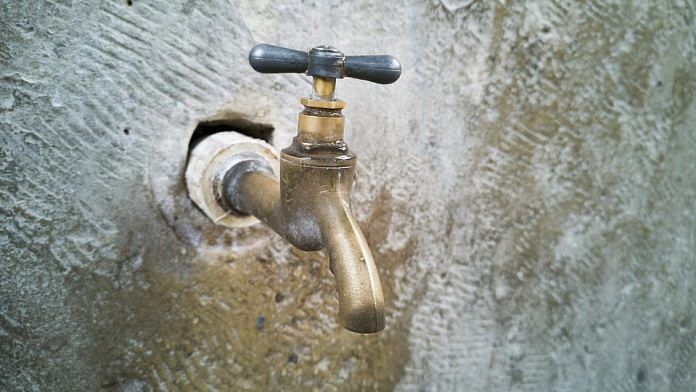New Delhi: In its first year of ensuring drinking water connections to every rural household, the Narendra Modi government has managed to cover all houses in nine districts of the country, including Srinagar and Ganderbal in Jammu and Kashmir, under the ‘Har Ghar Nal Se Jal’ programme.
Launched last year, the initiative envisions providing drinking water connections to every rural household by 2024.
Overall, 44.1 per cent of rural households in Jammu & Kashmir now have potable water connections. Government officials said this is a reflection of the thrust given by the government to push development works in the erstwhile state after Article 370, which granted special status to J&K, was removed in August last year.
However, work in Ladakh — the other new union territory that was carved out of the erstwhile state of J&K — has been slow with only 4.67 per cent households getting drinking water connections.
Besides Srinagar and Ganderbal in J&K, Lahaul and Spiti in Himachal Pradesh, Sahibzada Ajit Singh (SAS) Nagar in Punjab, Gandhinagar in Gujarat and Adilabad, Karimnagar, Warangal and Medchal-Malkajgiri in Telangana are the other districts where every rural household now has potable water connection, officials of the Department of Drinking Water under the Union Jal Shakti ministry said.

Also read: Modi govt wants states to employ returning migrant workers in Har Ghar Nal Se Jal projects
2 cr households covered under ‘Nal Se Jal’ so far
In all, 2 crore rural households have been provided new tap water connections in the last one year, PM Modi said from the ramparts of Red Fort during his Independence Day speech Saturday. This covers approximately 40,000 villages and 327 blocks of the country.
“Under the programme, 1.2 lakh to 1.4 lakh households are being provided new tap water connections every day,” said an official of the Department of Drinking Water and Sanitation (DDWS).
As much as 27 per cent of households in rural India have tap water connections. Of this, 11 per cent new connections were provided in the past year under the Har Ghar Nal Se Jal program.
The department recently completed revalidating the data related to rural households and the total number of functional taps provided by the states. According to this, at the time the scheme was launched last year, there were 17.87 crore households with only 3.23 crore households having piped water supply.
But on revalidation, the total number of households have now increased to 19 crore, of which 3.23 crore had functional taps at home from before. The number of households increased since Gujarat and Kerala had left out households in peri-urban areas, the DDWS official quoted above said.
Nal Se Jal has a unique model where villagers can control how much they pay for water depending on how much they consume. Pani samitis or water committees are being constituted in every village, which fix the tariff depending on a household’s water consumption. To encourage community participation, an innovative model has been worked out.
According to this, 10 per cent of the capital cost of the project is borne by the community. Once the project is completed, its ownership is transferred to the villagers along with the money they have contributed. The money is then used for operation and maintenance of the project.
Bharat Lal, DDWS additional secretary, who is in-charge of the Jal Jeevan Mission under which Nal Se Jal project is being executed, told ThePrint that the spirit of the programme is to make village community atmanirbhar (self-reliant) in water supply by helping them make their own decisions.
“Our endeavour is to facilitate gram panchayats to become local level public utility, managing drinking water source management, water supply to households, grey water reuse and regular operation and maintenance of systems at the village level,” Lal said.
This will help in developing responsible and responsive leadership in villages, he added. “This is one step ahead of empowering villagers where village people also become responsive and responsive to people’s needs.”
The programme has a total outlay of Rs 3.6 lakh crore and promises to provide over 15 crore rural households with 55 litre per capita per day drinking water of prescribed quality on a regular basis through a functional household tap.
While the Centre’s share is Rs 2.08 lakh crore, the remaining Rs 1.52 lakh crore is to be borne by states.
Also read: Under Nal Se Jal, villagers will decide how much they should pay for water they consume
Highest tap connections in Telangana, Bihar catching up
So far, Telangana has provided the highest number of potable water connections to rural households (98.29 per cent) followed by Goa (89 per cent) and Haryana (79.6 per cent).
In poll-bound Bihar, though, pace has now picked up in providing connections.
Between 1 April and 30 June 2020, Bihar provided functional tap water connections to 4.39 lakh households, the second highest among states and UTs, as against its target of 1.5 crore households for the 2020-21 financial year.
A ministry official said four states and UTs — Telangana, Bihar, Goa and Puducherry — are also in line to meet the target of providing piped water to 100 per cent of rural households by 2021, three years ahead of schedule.
Among the laggards are West Bengal, where only 2 per cent of households received connections, followed by Uttar Pradesh (4.49 per cent), Jharkhand (9.07 per cent), Odisha (11.63 per cent) and Chhattisgarh (11.83 per cent). The north-eastern states are also far behind their targets.
Also read: Coming soon — govt lab in every district where you can test your water supply for toxins




KCR in Telangana is already labeling it as his achievement.